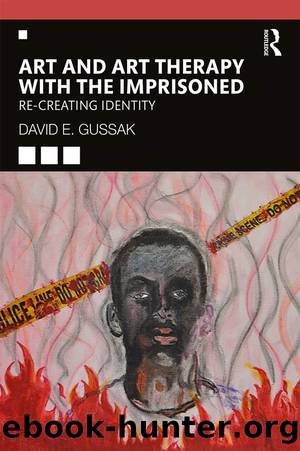Art and Art Therapy with the Imprisoned by Gussak David;

Author:Gussak, David; [Неизв.]
Language: eng
Format: epub
Publisher: Taylor & Francis (CAM)
Published: 2019-06-14T20:00:00+00:00
Since â¦
The research literature for art therapy in prison has since been expanding to include quantitative and qualitative inquiries. For example, Smeijsters Kil, Kurstjens, Welten, and Willemars presented their results in (2011) of the first phase of their research project to develop and evaluate the effectiveness of the arts therapiesâspecifically art, dance/movement, music, and dramaâwith youthful offenders in the Netherlands. The practice-based evidence that emerged from the naturalistic/constructivist research and grounded theory revealed that the interventions were instrumental in changing what they identified as the core problems with this population: âself-image, with expressing and discharging emotions, the inability to resolve interpersonal problems and finally, negative cognitionsâ (p. 41). Ferszt et al. (2004) relied on pre and post interviews of eight incarcerated women who took part in art therapy services to ascertain its effectiveness in mitigating their grief over the death of a loved one. Personâs 2009 article detailed the phenomenological approach to understanding the psychological needs of 46 delinquent incarcerated boys after receiving art therapy services for almost three years.
In 2005 Hartz and Thick developed a quasi-experimental study to ascertain not only the effectiveness of art therapy on the self-esteem of 27 female juvenile offenders, but to determine if there was any difference between those that received art psychotherapy and art as therapy. Relying on the results of the post-treatment application of the Harter Adolescent Self-Perception Profile (1988), they recognized that while there was statistically heightened improvement in behavioral conduct and in their ability to develop close friendships for those receiving art psychotherapy, and statistically greater improvement in social acceptance for those in art as therapy groups, all participants demonstrated marked improvement in global self-worth.
In 2017, Qiu, Ye, Liang, Huang, Liu, and Luâs randomized, longitudinal experimental study concluded that participating in the creative arts therapies was beneficial for prison inmates from two prisons on Mainland China, particularly those with schizophrenia. Specifically, their findings revealed that those who took part in an âart brut therapy programâ demonstrated a âdecrease in anxiety, depression and angerâ (p. 1069) and were ultimately more compliant with unit rules, were more social, compliant with medication, and developed better sleeping patterns. Ultimately, the 60 inmates that received the 16 weeks of services demonstrated a greater level of improvement than those in the control group. In 2018, Saita, Accordini, and Fenaroli explored the effects of phototherapy on the emotional intelligence [EI] of inmates in minimum and protective custodies in an Italian prison. What they discovered was that those in minimum custody did indeed demonstrate greater EI, yet those in protective custody demonstrated an increase in depressive symptoms. They concluded that this was because taking part in the sessions increased their awareness of their circumstances.
One of the most recent book publications, Rothwellâs Forensic Art Therapies: Anthology of Practice and Research (2016), provided a collection of papers presented at various Forensic Arts Therapies Advisory Group conferences on the effectiveness of the arts therapies and other non-traditional approaches with forensic populations, including art, music, drama, dance and movement, sand tray, play, and story-telling.
Download
This site does not store any files on its server. We only index and link to content provided by other sites. Please contact the content providers to delete copyright contents if any and email us, we'll remove relevant links or contents immediately.
| Administration & Medicine Economics | Allied Health Professions |
| Basic Sciences | Dentistry |
| History | Medical Informatics |
| Medicine | Nursing |
| Pharmacology | Psychology |
| Research | Veterinary Medicine |
Periodization Training for Sports by Tudor Bompa(8175)
Why We Sleep: Unlocking the Power of Sleep and Dreams by Matthew Walker(6620)
Paper Towns by Green John(5094)
The Immortal Life of Henrietta Lacks by Rebecca Skloot(4528)
The Sports Rules Book by Human Kinetics(4304)
Dynamic Alignment Through Imagery by Eric Franklin(4125)
ACSM's Complete Guide to Fitness & Health by ACSM(3992)
Kaplan MCAT Organic Chemistry Review: Created for MCAT 2015 (Kaplan Test Prep) by Kaplan(3942)
Introduction to Kinesiology by Shirl J. Hoffman(3728)
Livewired by David Eagleman(3688)
The Death of the Heart by Elizabeth Bowen(3555)
The River of Consciousness by Oliver Sacks(3543)
Alchemy and Alchemists by C. J. S. Thompson(3452)
Bad Pharma by Ben Goldacre(3359)
Descartes' Error by Antonio Damasio(3232)
The Emperor of All Maladies: A Biography of Cancer by Siddhartha Mukherjee(3071)
The Gene: An Intimate History by Siddhartha Mukherjee(3050)
The Fate of Rome: Climate, Disease, and the End of an Empire (The Princeton History of the Ancient World) by Kyle Harper(3007)
Kaplan MCAT Behavioral Sciences Review: Created for MCAT 2015 (Kaplan Test Prep) by Kaplan(2941)
